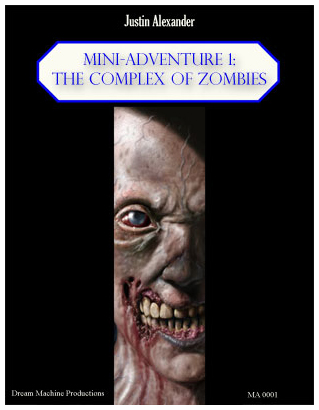Dream Machine Productions rolls out its second major product line today with Mini-Adventure 1: The Complex of Zombies.
This release also gives me a chance to reveal a new layout for adventure modules. I’ve long felt that adventure modules in the roleplaying industry have been struggling under a legacy of inefficient and ineffective layouts. The information in adventure modules is simply not presented in a fashion which makes it easy to reference or use during gameplay. Attempts to remedy this in recent years by various companies and creators have more often resulted in either (a) artificial one-size-fits-all organizational schemes which actually make the information for many encounters more opaque and difficult to process as the author tries to cram it into the preset categories; or (b) elaborate Rube Goldberg devices that don’t seem to actually accomplish anything.
What you’ll find in The Complex of Zombies is not a radical departure. It’s not something that’s going to leap off the page at you and slap you in the face with its brilliance. It’s not going to require you to completely relearn how to process and use the adventure.
It is better thought of as a tidying. Or perhaps a tweaking.
Here are the major things I’ve tried to accomplish:
1. Each encounter is given a clear-cut possession to a slice of page space. They are positioned on the page in a way which makes it easy to quickly and easily find any given encounter key when you need to. This is accomplished by, in general, giving each encounter its own column: This means that encounter numbers can be clearly found at the top of each page, and each encounter is clearly delineated from each other. (There are two exceptions: Particularly shot encounter keys may end up being listed two to a column. Longer encounter keys may require more than a single column.)
2. The information in each encounter key is sub-divided into a number of smaller, bite-size chunks that can be quickly processed at a glance. (For example, you don’t need to dig through an entire paragraph of text to discover — buried somewhere near its center — that there is relevant information to be gained from a Spot check in this area.) These bite-size chunks of data are described with clear titles in bold-face, which makes it easy for the DM to quickly process all the important elements of an encounter at a single glance and then pull out the information they need as they need it.
3. The presentation of certain types of information — particularly skill checks — are standardized, making it easier to find that information on the page and use that information while running the adventure. (But such standardization takes place at a fairly low-level of information, where such standardization makes the most sense. At the macro-level, the description of the encounter is structured and ordered in the way which makes the most sense for that particular encounter.)
4. Boxed text for every keyed encounter area. More importantly, this boxed text is properly implemented, which means that it: (a) Makes a consistent assumption of the illumination available to the PCs (and clearly states what this standard is). (b) Never assumes that the PCs are entering an area from a particular direction or at a particular time. (c) Never assumes that the PCs will take certain actions or attempt to make decisions for the PCs. (Not everyone will use boxed text verbatim, but properly executed boxed text is valuable nonetheless because it clearly delineates between “what the PCs will immediately know (and should know) about an encounter area” (the boxed text) and “what the PCs may discover about or do in an encounter area” (everything else in the encounter description.)
As I say, none of these things are radical departures by any stretch of the imagination. But I think that you’ll find that these subtle changes, when taken together, result in an adventure module which is clearer in its presentation, cleaner in its preparation, and easier in its running than anything you’ve seen before. You can take a peek at it by following the link and looking at the Lulu preview.
 SECRETS OF BLOOD, MYSTERIES OF JADE…
SECRETS OF BLOOD, MYSTERIES OF JADE…
In a laboratory of stone, the Sons of Jade labored to unlock the arcane lore of the Jade Magi of Shandrala. But their efforts were doomed, and their entire complex was drenched in the blood of their failure.
Now the secrets of the necrosis cube and the orb of primal chaos lie in halls roamed only by desiccated, undead horrors. But these are no ordinary zombies, and those who would seek to reclaim the Jade Legacy must first learn the terror of the bloodsheen…
Buy PDF – Print Edition
20 pages – Sample Map
The Complex of Zombies, an adventure for four 3rd-level characters, features a full-page map of the complex; flexible plot hooks; three new magic items; and two new monsters in an exciting, fast-paced adventure easily incorporated into any campaign!
That beautiful cover art is the work of Bernard Bittler. Bittler is an accomplished artist who has taken an active role in developing video, board, and roleplaying games, including RuneQuest, Chill, Fable, and Iron Storm (among others). A gallery of his work can be found here. He lives in Paris, France.












Hey Justin, the links on this page to Lulu are broken. Could you change them to point to drivetrurpg?